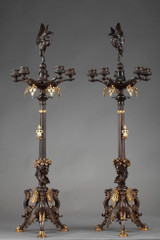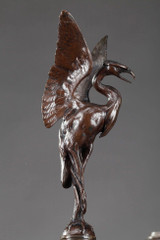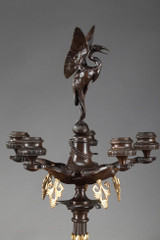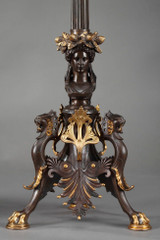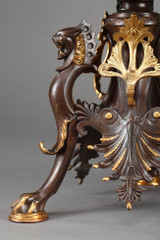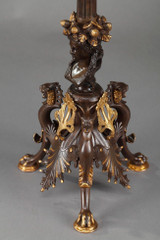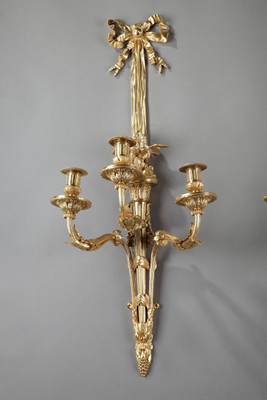patinated and gilt bronze floor candelabra, candelabra is adorned with openwork chimeras and foliage in gilt bronze, above three claw feet. It is surmounted by a bust of a woman with an antique hairstyle and a crown of tassels. The fluted stem supports five finely chased egg-and-dart candle holders, each topped with a heron. The decoration of these antique candelabra is typical of the Neo-Greek style that became widespread in France in the mid-19th century.
The Neo-Greek style in the 19th century
In mid-19th-century decorative arts, the Neo-Greek style was based on the repertoire of Greco-Roman ornamentation, combining motifs from Greek vase painting and repetitive architectural patterns such as hymns, palmettes, and Greek keys with Louis XVI style elements. The Neo-Greek style can be identified by the frequent use of isolated motifs of classical heads and figures, masks, winged griffins, sea serpents, urns, and so on. This eclectic style is abstract, polychrome, and sometimes unusual. The color harmonies typical of Neo-Greek were rich and bold: black motifs and outlines against Pompeian red, and gold combined with a black patina, as seen in this pair of candlesticks we are offering. Our pair of candlesticks can be compared to the production of George Emile Servant (1828-1890) who specialized at the same time in Neo-Greek style bronzes and clocks.
Condition report : in very good overall condition, with micro scratches from use on the bronze.
Delivery
Europe: €0
US/Canada/HK: €0
Rest of the world: Price upon request
- Reference :
- 2511
- Availability :
- Item available
- Width :
- 26 (cm)
- Height :
- 80 (cm)
- Depth :
- 26 (cm)
- Era:
- 19th century
- Style:
- Neo-Greek
- Materials:
- Bronze

